Reproductive and Sexual Health: Disability Intervention Analysis
VerifiedAdded on 2022/12/27
|10
|2485
|20
Report
AI Summary
This report provides an analysis of various interventions related to reproductive and sexual health, with a specific focus on individuals with intellectual disabilities. The analysis includes summaries of five research papers, each addressing different aspects of sexual health interventions. The papers cover topics such as transgender individuals and their sexual health experiences, sexuality interventions for youth, sexuality education, and factors influencing adolescent pregnancy. The report examines the methods, findings, and recommendations of each study, highlighting the importance of addressing discrimination, promoting comprehensive sexuality education, and providing accessible healthcare services. The studies emphasize the need for increased knowledge among healthcare professionals and the development of person-centered care to improve sexual health outcomes for diverse populations. The report also considers the human rights implications of these interventions, underscoring the importance of equitable access to information and services.
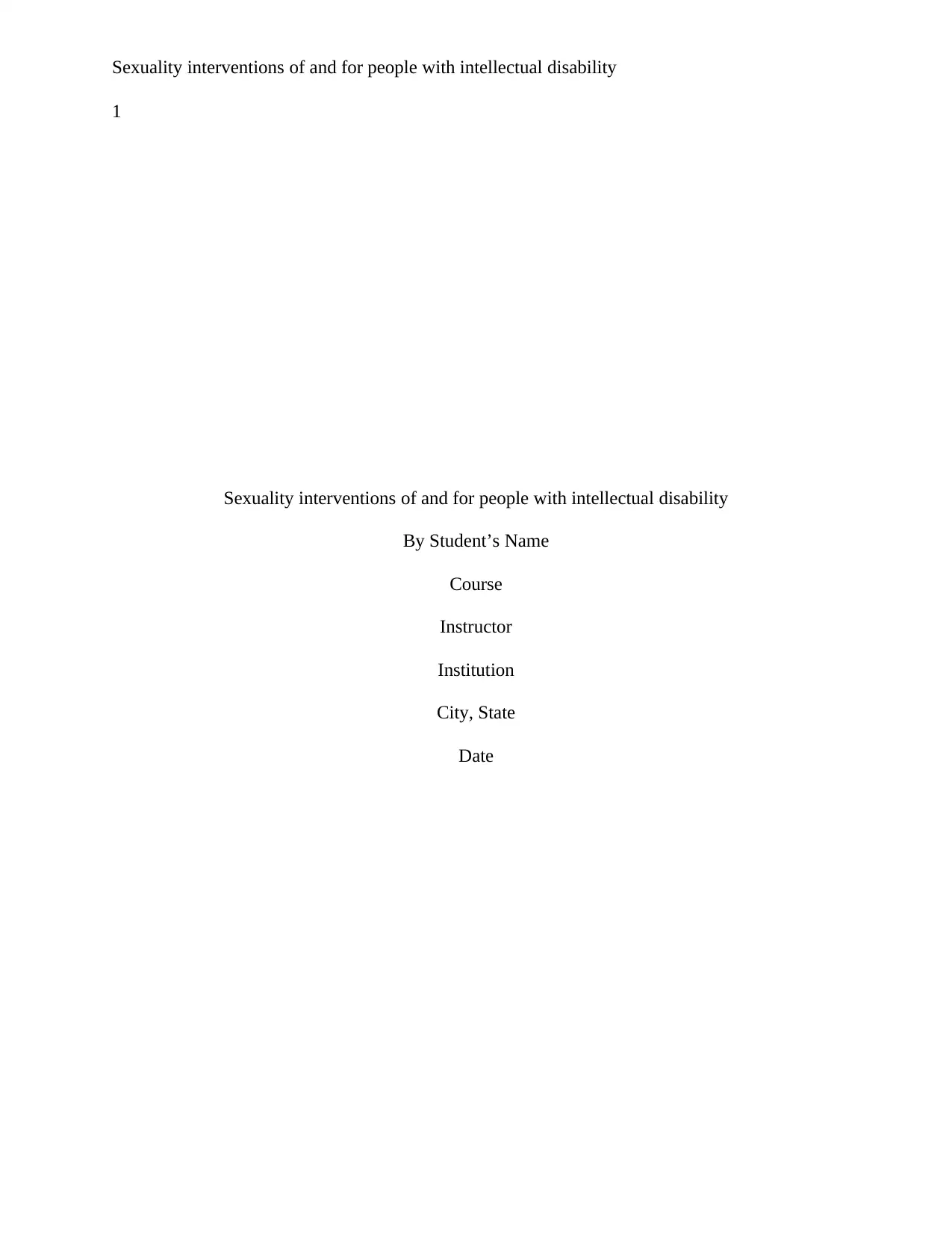
Sexuality interventions of and for people with intellectual disability
1
Sexuality interventions of and for people with intellectual disability
By Student’s Name
Course
Instructor
Institution
City, State
Date
1
Sexuality interventions of and for people with intellectual disability
By Student’s Name
Course
Instructor
Institution
City, State
Date
Paraphrase This Document
Need a fresh take? Get an instant paraphrase of this document with our AI Paraphraser
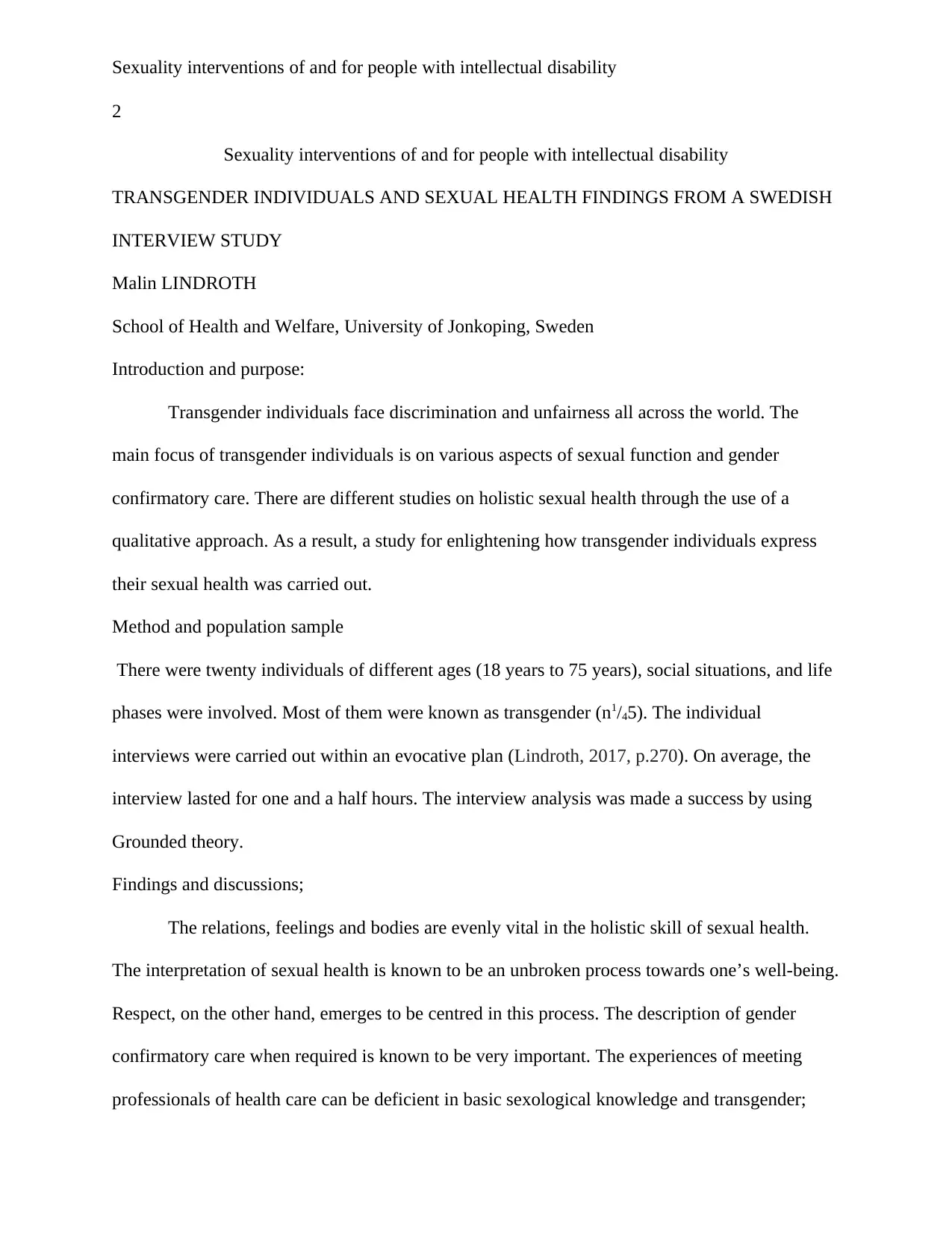
Sexuality interventions of and for people with intellectual disability
2
Sexuality interventions of and for people with intellectual disability
TRANSGENDER INDIVIDUALS AND SEXUAL HEALTH FINDINGS FROM A SWEDISH
INTERVIEW STUDY
Malin LINDROTH
School of Health and Welfare, University of Jonkoping, Sweden
Introduction and purpose:
Transgender individuals face discrimination and unfairness all across the world. The
main focus of transgender individuals is on various aspects of sexual function and gender
confirmatory care. There are different studies on holistic sexual health through the use of a
qualitative approach. As a result, a study for enlightening how transgender individuals express
their sexual health was carried out.
Method and population sample
There were twenty individuals of different ages (18 years to 75 years), social situations, and life
phases were involved. Most of them were known as transgender (n1/45). The individual
interviews were carried out within an evocative plan (Lindroth, 2017, p.270). On average, the
interview lasted for one and a half hours. The interview analysis was made a success by using
Grounded theory.
Findings and discussions;
The relations, feelings and bodies are evenly vital in the holistic skill of sexual health.
The interpretation of sexual health is known to be an unbroken process towards one’s well-being.
Respect, on the other hand, emerges to be centred in this process. The description of gender
confirmatory care when required is known to be very important. The experiences of meeting
professionals of health care can be deficient in basic sexological knowledge and transgender;
2
Sexuality interventions of and for people with intellectual disability
TRANSGENDER INDIVIDUALS AND SEXUAL HEALTH FINDINGS FROM A SWEDISH
INTERVIEW STUDY
Malin LINDROTH
School of Health and Welfare, University of Jonkoping, Sweden
Introduction and purpose:
Transgender individuals face discrimination and unfairness all across the world. The
main focus of transgender individuals is on various aspects of sexual function and gender
confirmatory care. There are different studies on holistic sexual health through the use of a
qualitative approach. As a result, a study for enlightening how transgender individuals express
their sexual health was carried out.
Method and population sample
There were twenty individuals of different ages (18 years to 75 years), social situations, and life
phases were involved. Most of them were known as transgender (n1/45). The individual
interviews were carried out within an evocative plan (Lindroth, 2017, p.270). On average, the
interview lasted for one and a half hours. The interview analysis was made a success by using
Grounded theory.
Findings and discussions;
The relations, feelings and bodies are evenly vital in the holistic skill of sexual health.
The interpretation of sexual health is known to be an unbroken process towards one’s well-being.
Respect, on the other hand, emerges to be centred in this process. The description of gender
confirmatory care when required is known to be very important. The experiences of meeting
professionals of health care can be deficient in basic sexological knowledge and transgender;
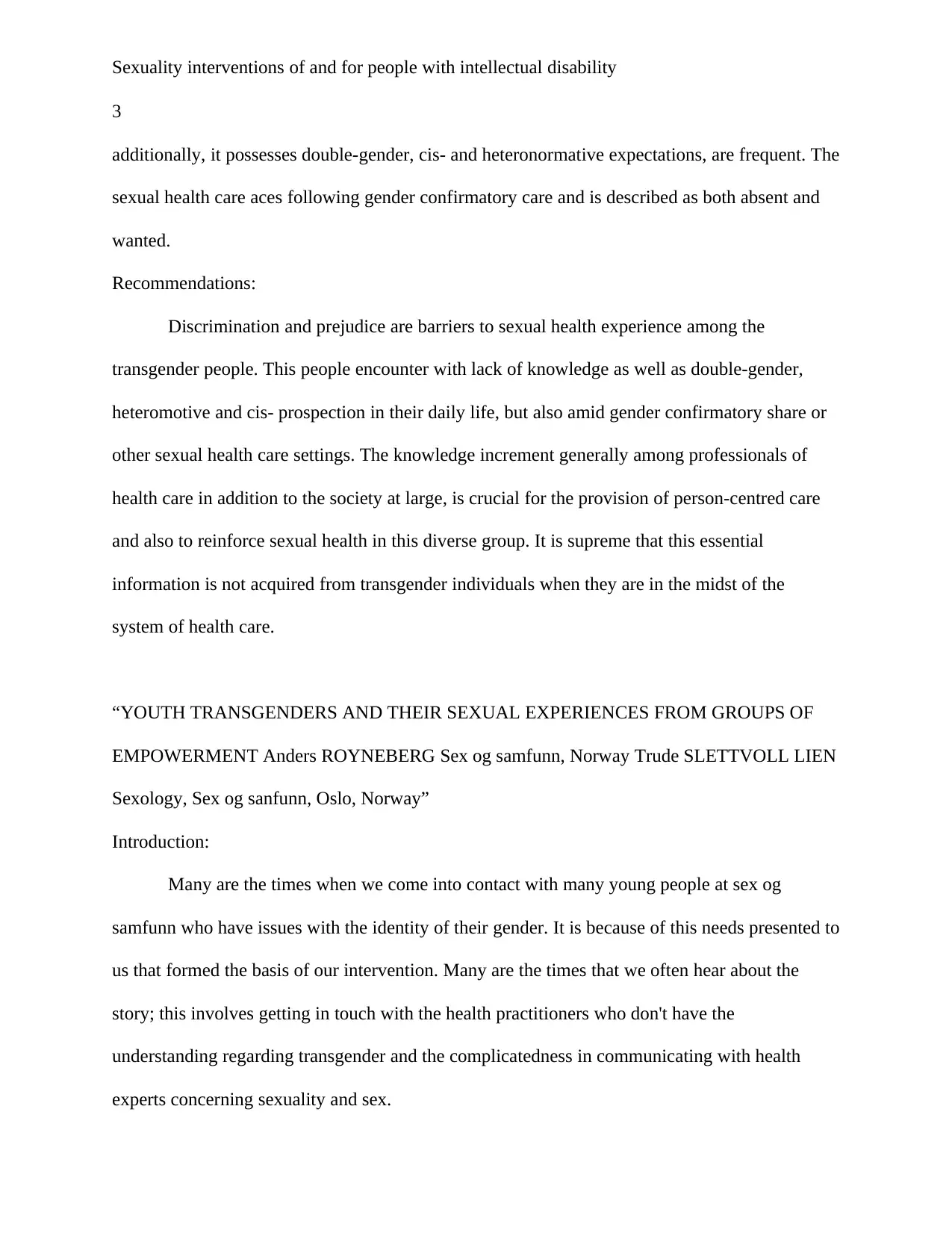
Sexuality interventions of and for people with intellectual disability
3
additionally, it possesses double-gender, cis- and heteronormative expectations, are frequent. The
sexual health care aces following gender confirmatory care and is described as both absent and
wanted.
Recommendations:
Discrimination and prejudice are barriers to sexual health experience among the
transgender people. This people encounter with lack of knowledge as well as double-gender,
heteromotive and cis- prospection in their daily life, but also amid gender confirmatory share or
other sexual health care settings. The knowledge increment generally among professionals of
health care in addition to the society at large, is crucial for the provision of person-centred care
and also to reinforce sexual health in this diverse group. It is supreme that this essential
information is not acquired from transgender individuals when they are in the midst of the
system of health care.
“YOUTH TRANSGENDERS AND THEIR SEXUAL EXPERIENCES FROM GROUPS OF
EMPOWERMENT Anders ROYNEBERG Sex og samfunn, Norway Trude SLETTVOLL LIEN
Sexology, Sex og sanfunn, Oslo, Norway”
Introduction:
Many are the times when we come into contact with many young people at sex og
samfunn who have issues with the identity of their gender. It is because of this needs presented to
us that formed the basis of our intervention. Many are the times that we often hear about the
story; this involves getting in touch with the health practitioners who don't have the
understanding regarding transgender and the complicatedness in communicating with health
experts concerning sexuality and sex.
3
additionally, it possesses double-gender, cis- and heteronormative expectations, are frequent. The
sexual health care aces following gender confirmatory care and is described as both absent and
wanted.
Recommendations:
Discrimination and prejudice are barriers to sexual health experience among the
transgender people. This people encounter with lack of knowledge as well as double-gender,
heteromotive and cis- prospection in their daily life, but also amid gender confirmatory share or
other sexual health care settings. The knowledge increment generally among professionals of
health care in addition to the society at large, is crucial for the provision of person-centred care
and also to reinforce sexual health in this diverse group. It is supreme that this essential
information is not acquired from transgender individuals when they are in the midst of the
system of health care.
“YOUTH TRANSGENDERS AND THEIR SEXUAL EXPERIENCES FROM GROUPS OF
EMPOWERMENT Anders ROYNEBERG Sex og samfunn, Norway Trude SLETTVOLL LIEN
Sexology, Sex og sanfunn, Oslo, Norway”
Introduction:
Many are the times when we come into contact with many young people at sex og
samfunn who have issues with the identity of their gender. It is because of this needs presented to
us that formed the basis of our intervention. Many are the times that we often hear about the
story; this involves getting in touch with the health practitioners who don't have the
understanding regarding transgender and the complicatedness in communicating with health
experts concerning sexuality and sex.
⊘ This is a preview!⊘
Do you want full access?
Subscribe today to unlock all pages.

Trusted by 1+ million students worldwide
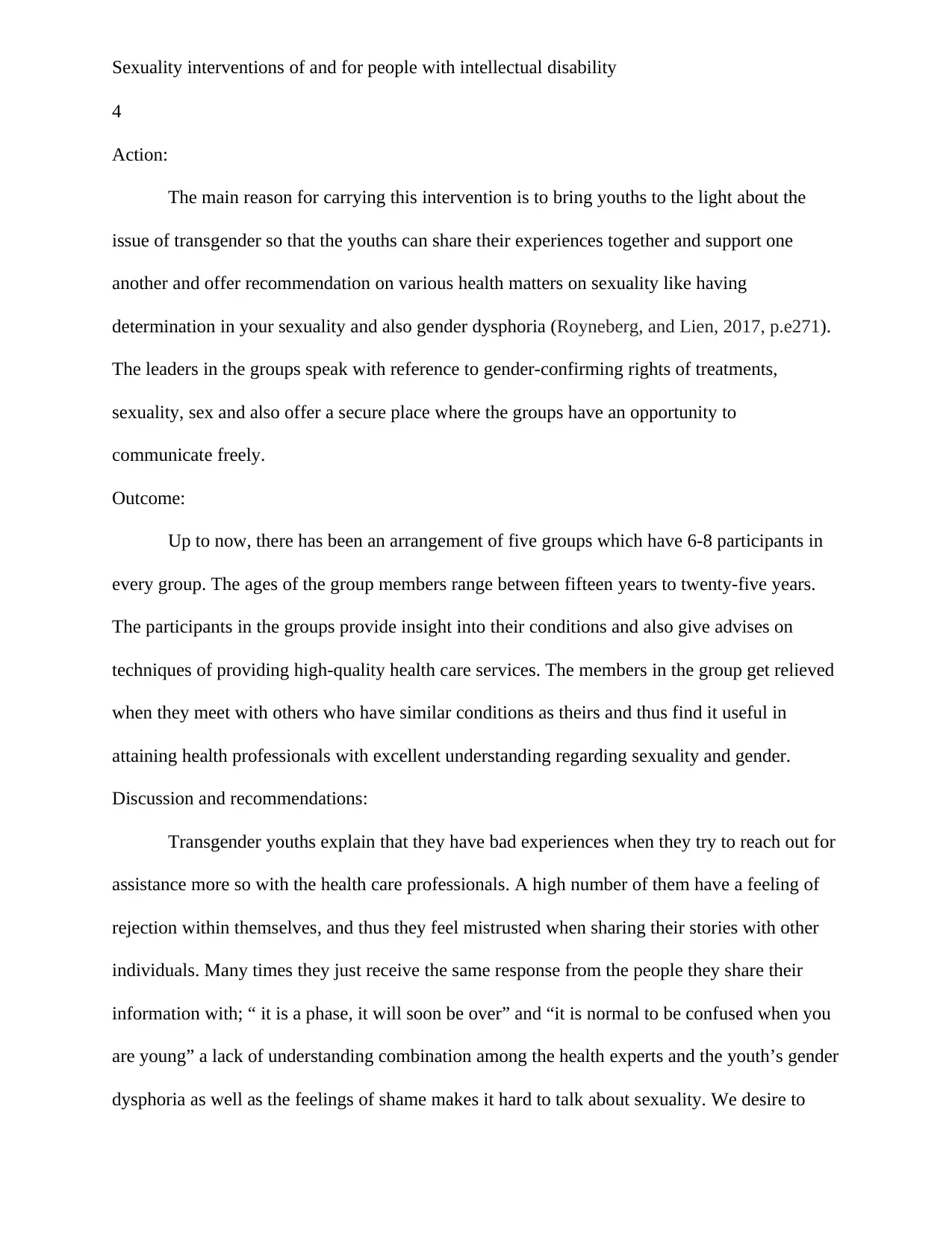
Sexuality interventions of and for people with intellectual disability
4
Action:
The main reason for carrying this intervention is to bring youths to the light about the
issue of transgender so that the youths can share their experiences together and support one
another and offer recommendation on various health matters on sexuality like having
determination in your sexuality and also gender dysphoria (Royneberg, and Lien, 2017, p.e271).
The leaders in the groups speak with reference to gender-confirming rights of treatments,
sexuality, sex and also offer a secure place where the groups have an opportunity to
communicate freely.
Outcome:
Up to now, there has been an arrangement of five groups which have 6-8 participants in
every group. The ages of the group members range between fifteen years to twenty-five years.
The participants in the groups provide insight into their conditions and also give advises on
techniques of providing high-quality health care services. The members in the group get relieved
when they meet with others who have similar conditions as theirs and thus find it useful in
attaining health professionals with excellent understanding regarding sexuality and gender.
Discussion and recommendations:
Transgender youths explain that they have bad experiences when they try to reach out for
assistance more so with the health care professionals. A high number of them have a feeling of
rejection within themselves, and thus they feel mistrusted when sharing their stories with other
individuals. Many times they just receive the same response from the people they share their
information with; “ it is a phase, it will soon be over” and “it is normal to be confused when you
are young” a lack of understanding combination among the health experts and the youth’s gender
dysphoria as well as the feelings of shame makes it hard to talk about sexuality. We desire to
4
Action:
The main reason for carrying this intervention is to bring youths to the light about the
issue of transgender so that the youths can share their experiences together and support one
another and offer recommendation on various health matters on sexuality like having
determination in your sexuality and also gender dysphoria (Royneberg, and Lien, 2017, p.e271).
The leaders in the groups speak with reference to gender-confirming rights of treatments,
sexuality, sex and also offer a secure place where the groups have an opportunity to
communicate freely.
Outcome:
Up to now, there has been an arrangement of five groups which have 6-8 participants in
every group. The ages of the group members range between fifteen years to twenty-five years.
The participants in the groups provide insight into their conditions and also give advises on
techniques of providing high-quality health care services. The members in the group get relieved
when they meet with others who have similar conditions as theirs and thus find it useful in
attaining health professionals with excellent understanding regarding sexuality and gender.
Discussion and recommendations:
Transgender youths explain that they have bad experiences when they try to reach out for
assistance more so with the health care professionals. A high number of them have a feeling of
rejection within themselves, and thus they feel mistrusted when sharing their stories with other
individuals. Many times they just receive the same response from the people they share their
information with; “ it is a phase, it will soon be over” and “it is normal to be confused when you
are young” a lack of understanding combination among the health experts and the youth’s gender
dysphoria as well as the feelings of shame makes it hard to talk about sexuality. We desire to
Paraphrase This Document
Need a fresh take? Get an instant paraphrase of this document with our AI Paraphraser

Sexuality interventions of and for people with intellectual disability
5
raise the understanding of the health experts by sharing our know-how and the desires of the
group members’ as well as the needs for better health care services.
“SEX FOR EVERYONE: SEXUALITY INTERVENTIONS OF AND FOR THE PEOPLE
WITH INTELLECTUAL DISABILITIES Becky NELSON Swedish Association for Sexuality
Education, Malmo, Sweden; 2 Social Medicine and Global Health, University of Lund, Malmo
Sweden”
Rationale and introduction:
Rights to sexual and reproductive health care and the rights to information in general.
Nevertheless, for people who have intellectual disability, this right does not exist for them. These
are the individuals who have increased the risk for sexual abuse and also have poor sexual
health.
Action:
This intervention made use of peer instructors to create room and chance for individuals
who are disabled intellectually to investigate the questions of sexuality. Sexual instructors, with
and without disabilities intellectually, hold a workshop for individuals possessing disabilities
intellectually in assisted living and places of work in southern Sweden (Morin, Levesque, and
Lavigne, 2017, p.e270). Theories of peer education and communication work were applied in the
development of projects whereby the educators of sex prejudiced the delivery of sexual health
workshops, the content and the context. Discussing topics applied the use of pictures, stories and
films within the reproductive and sexual health and rights, including relationships, infections
transmitted sexually, contraception and sex practices.
Outcome:
5
raise the understanding of the health experts by sharing our know-how and the desires of the
group members’ as well as the needs for better health care services.
“SEX FOR EVERYONE: SEXUALITY INTERVENTIONS OF AND FOR THE PEOPLE
WITH INTELLECTUAL DISABILITIES Becky NELSON Swedish Association for Sexuality
Education, Malmo, Sweden; 2 Social Medicine and Global Health, University of Lund, Malmo
Sweden”
Rationale and introduction:
Rights to sexual and reproductive health care and the rights to information in general.
Nevertheless, for people who have intellectual disability, this right does not exist for them. These
are the individuals who have increased the risk for sexual abuse and also have poor sexual
health.
Action:
This intervention made use of peer instructors to create room and chance for individuals
who are disabled intellectually to investigate the questions of sexuality. Sexual instructors, with
and without disabilities intellectually, hold a workshop for individuals possessing disabilities
intellectually in assisted living and places of work in southern Sweden (Morin, Levesque, and
Lavigne, 2017, p.e270). Theories of peer education and communication work were applied in the
development of projects whereby the educators of sex prejudiced the delivery of sexual health
workshops, the content and the context. Discussing topics applied the use of pictures, stories and
films within the reproductive and sexual health and rights, including relationships, infections
transmitted sexually, contraception and sex practices.
Outcome:
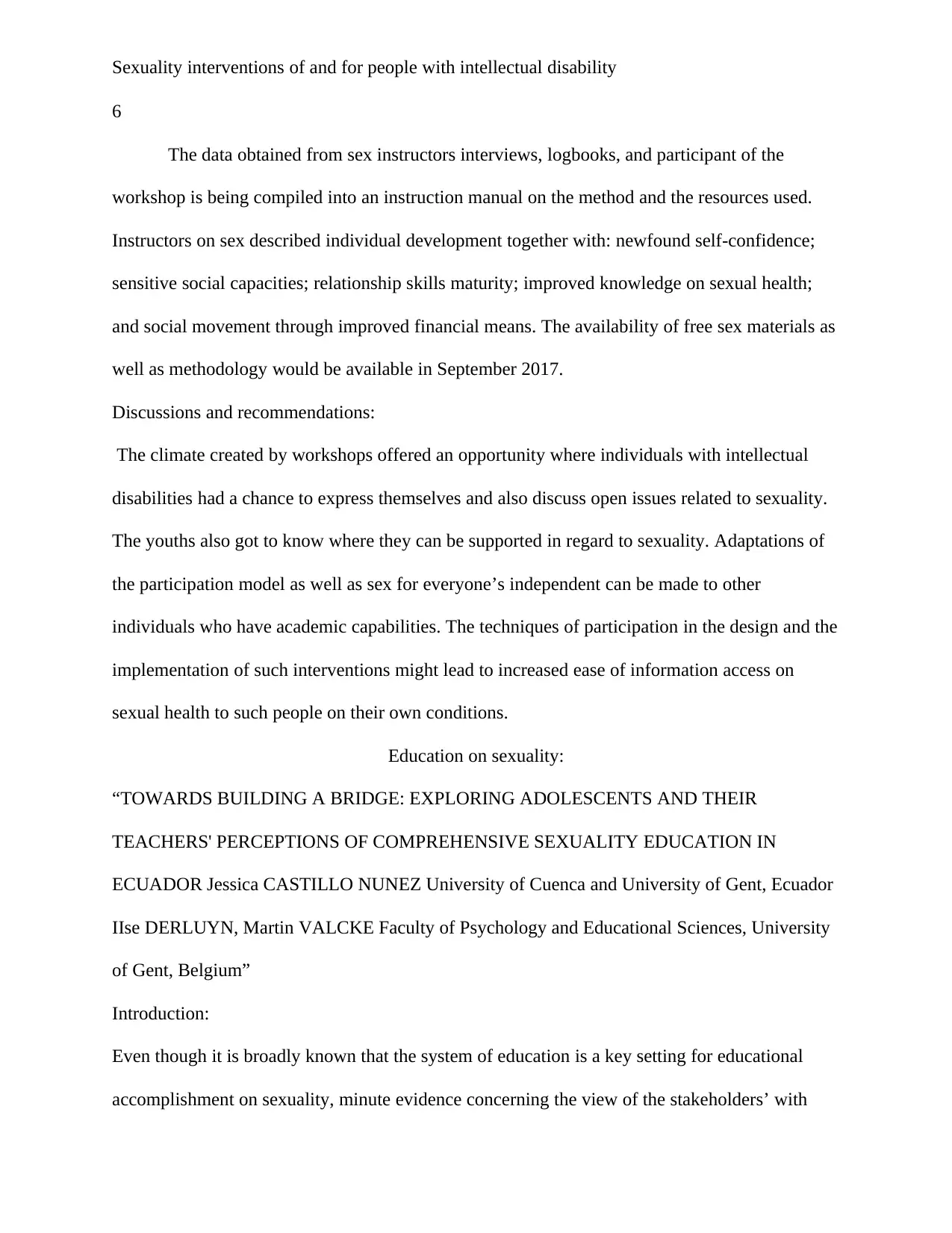
Sexuality interventions of and for people with intellectual disability
6
The data obtained from sex instructors interviews, logbooks, and participant of the
workshop is being compiled into an instruction manual on the method and the resources used.
Instructors on sex described individual development together with: newfound self-confidence;
sensitive social capacities; relationship skills maturity; improved knowledge on sexual health;
and social movement through improved financial means. The availability of free sex materials as
well as methodology would be available in September 2017.
Discussions and recommendations:
The climate created by workshops offered an opportunity where individuals with intellectual
disabilities had a chance to express themselves and also discuss open issues related to sexuality.
The youths also got to know where they can be supported in regard to sexuality. Adaptations of
the participation model as well as sex for everyone’s independent can be made to other
individuals who have academic capabilities. The techniques of participation in the design and the
implementation of such interventions might lead to increased ease of information access on
sexual health to such people on their own conditions.
Education on sexuality:
“TOWARDS BUILDING A BRIDGE: EXPLORING ADOLESCENTS AND THEIR
TEACHERS' PERCEPTIONS OF COMPREHENSIVE SEXUALITY EDUCATION IN
ECUADOR Jessica CASTILLO NUNEZ University of Cuenca and University of Gent, Ecuador
IIse DERLUYN, Martin VALCKE Faculty of Psychology and Educational Sciences, University
of Gent, Belgium”
Introduction:
Even though it is broadly known that the system of education is a key setting for educational
accomplishment on sexuality, minute evidence concerning the view of the stakeholders’ with
6
The data obtained from sex instructors interviews, logbooks, and participant of the
workshop is being compiled into an instruction manual on the method and the resources used.
Instructors on sex described individual development together with: newfound self-confidence;
sensitive social capacities; relationship skills maturity; improved knowledge on sexual health;
and social movement through improved financial means. The availability of free sex materials as
well as methodology would be available in September 2017.
Discussions and recommendations:
The climate created by workshops offered an opportunity where individuals with intellectual
disabilities had a chance to express themselves and also discuss open issues related to sexuality.
The youths also got to know where they can be supported in regard to sexuality. Adaptations of
the participation model as well as sex for everyone’s independent can be made to other
individuals who have academic capabilities. The techniques of participation in the design and the
implementation of such interventions might lead to increased ease of information access on
sexual health to such people on their own conditions.
Education on sexuality:
“TOWARDS BUILDING A BRIDGE: EXPLORING ADOLESCENTS AND THEIR
TEACHERS' PERCEPTIONS OF COMPREHENSIVE SEXUALITY EDUCATION IN
ECUADOR Jessica CASTILLO NUNEZ University of Cuenca and University of Gent, Ecuador
IIse DERLUYN, Martin VALCKE Faculty of Psychology and Educational Sciences, University
of Gent, Belgium”
Introduction:
Even though it is broadly known that the system of education is a key setting for educational
accomplishment on sexuality, minute evidence concerning the view of the stakeholders’ with
⊘ This is a preview!⊘
Do you want full access?
Subscribe today to unlock all pages.

Trusted by 1+ million students worldwide
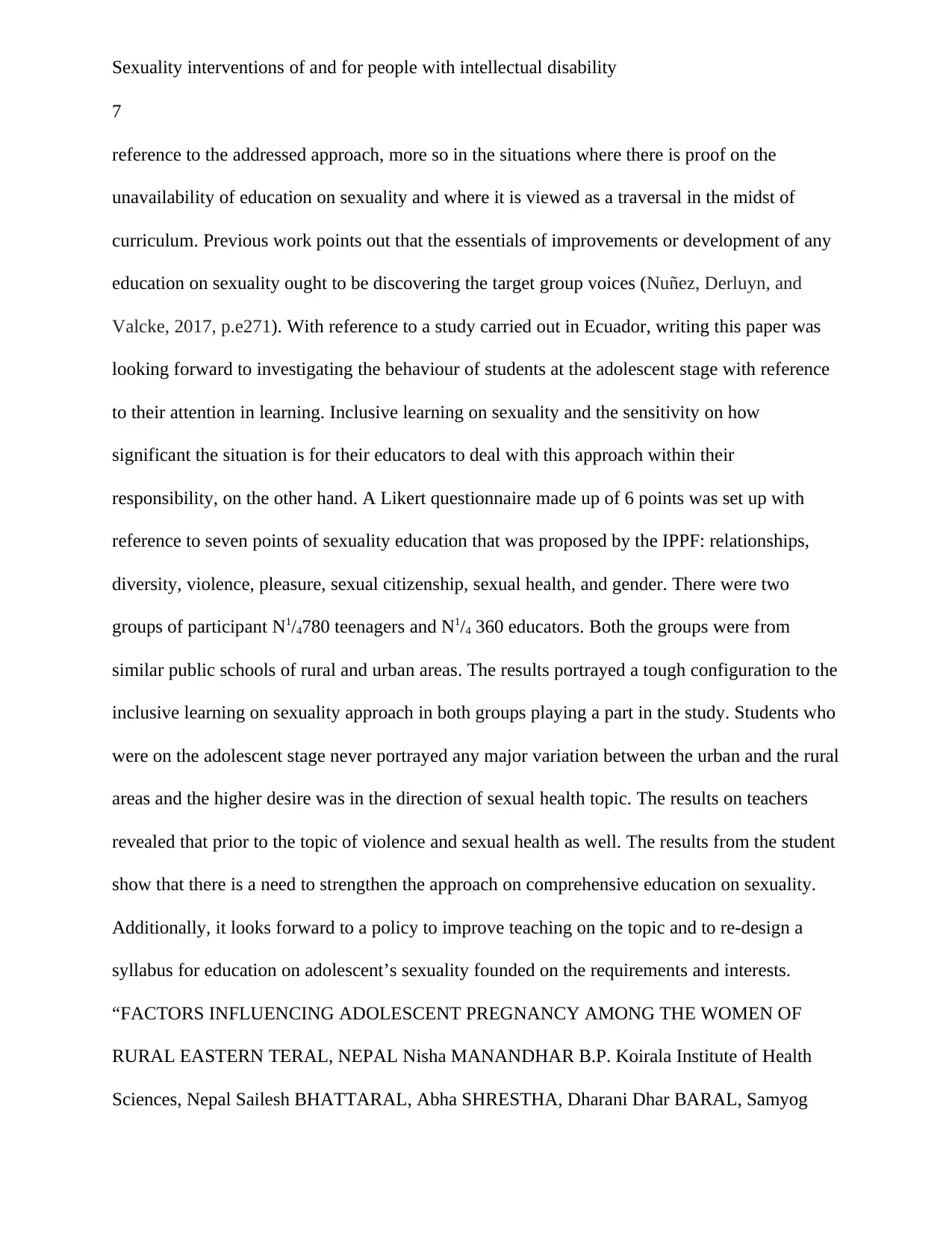
Sexuality interventions of and for people with intellectual disability
7
reference to the addressed approach, more so in the situations where there is proof on the
unavailability of education on sexuality and where it is viewed as a traversal in the midst of
curriculum. Previous work points out that the essentials of improvements or development of any
education on sexuality ought to be discovering the target group voices (Nuñez, Derluyn, and
Valcke, 2017, p.e271). With reference to a study carried out in Ecuador, writing this paper was
looking forward to investigating the behaviour of students at the adolescent stage with reference
to their attention in learning. Inclusive learning on sexuality and the sensitivity on how
significant the situation is for their educators to deal with this approach within their
responsibility, on the other hand. A Likert questionnaire made up of 6 points was set up with
reference to seven points of sexuality education that was proposed by the IPPF: relationships,
diversity, violence, pleasure, sexual citizenship, sexual health, and gender. There were two
groups of participant N1/4780 teenagers and N1/4 360 educators. Both the groups were from
similar public schools of rural and urban areas. The results portrayed a tough configuration to the
inclusive learning on sexuality approach in both groups playing a part in the study. Students who
were on the adolescent stage never portrayed any major variation between the urban and the rural
areas and the higher desire was in the direction of sexual health topic. The results on teachers
revealed that prior to the topic of violence and sexual health as well. The results from the student
show that there is a need to strengthen the approach on comprehensive education on sexuality.
Additionally, it looks forward to a policy to improve teaching on the topic and to re-design a
syllabus for education on adolescent’s sexuality founded on the requirements and interests.
“FACTORS INFLUENCING ADOLESCENT PREGNANCY AMONG THE WOMEN OF
RURAL EASTERN TERAL, NEPAL Nisha MANANDHAR B.P. Koirala Institute of Health
Sciences, Nepal Sailesh BHATTARAL, Abha SHRESTHA, Dharani Dhar BARAL, Samyog
7
reference to the addressed approach, more so in the situations where there is proof on the
unavailability of education on sexuality and where it is viewed as a traversal in the midst of
curriculum. Previous work points out that the essentials of improvements or development of any
education on sexuality ought to be discovering the target group voices (Nuñez, Derluyn, and
Valcke, 2017, p.e271). With reference to a study carried out in Ecuador, writing this paper was
looking forward to investigating the behaviour of students at the adolescent stage with reference
to their attention in learning. Inclusive learning on sexuality and the sensitivity on how
significant the situation is for their educators to deal with this approach within their
responsibility, on the other hand. A Likert questionnaire made up of 6 points was set up with
reference to seven points of sexuality education that was proposed by the IPPF: relationships,
diversity, violence, pleasure, sexual citizenship, sexual health, and gender. There were two
groups of participant N1/4780 teenagers and N1/4 360 educators. Both the groups were from
similar public schools of rural and urban areas. The results portrayed a tough configuration to the
inclusive learning on sexuality approach in both groups playing a part in the study. Students who
were on the adolescent stage never portrayed any major variation between the urban and the rural
areas and the higher desire was in the direction of sexual health topic. The results on teachers
revealed that prior to the topic of violence and sexual health as well. The results from the student
show that there is a need to strengthen the approach on comprehensive education on sexuality.
Additionally, it looks forward to a policy to improve teaching on the topic and to re-design a
syllabus for education on adolescent’s sexuality founded on the requirements and interests.
“FACTORS INFLUENCING ADOLESCENT PREGNANCY AMONG THE WOMEN OF
RURAL EASTERN TERAL, NEPAL Nisha MANANDHAR B.P. Koirala Institute of Health
Sciences, Nepal Sailesh BHATTARAL, Abha SHRESTHA, Dharani Dhar BARAL, Samyog
Paraphrase This Document
Need a fresh take? Get an instant paraphrase of this document with our AI Paraphraser
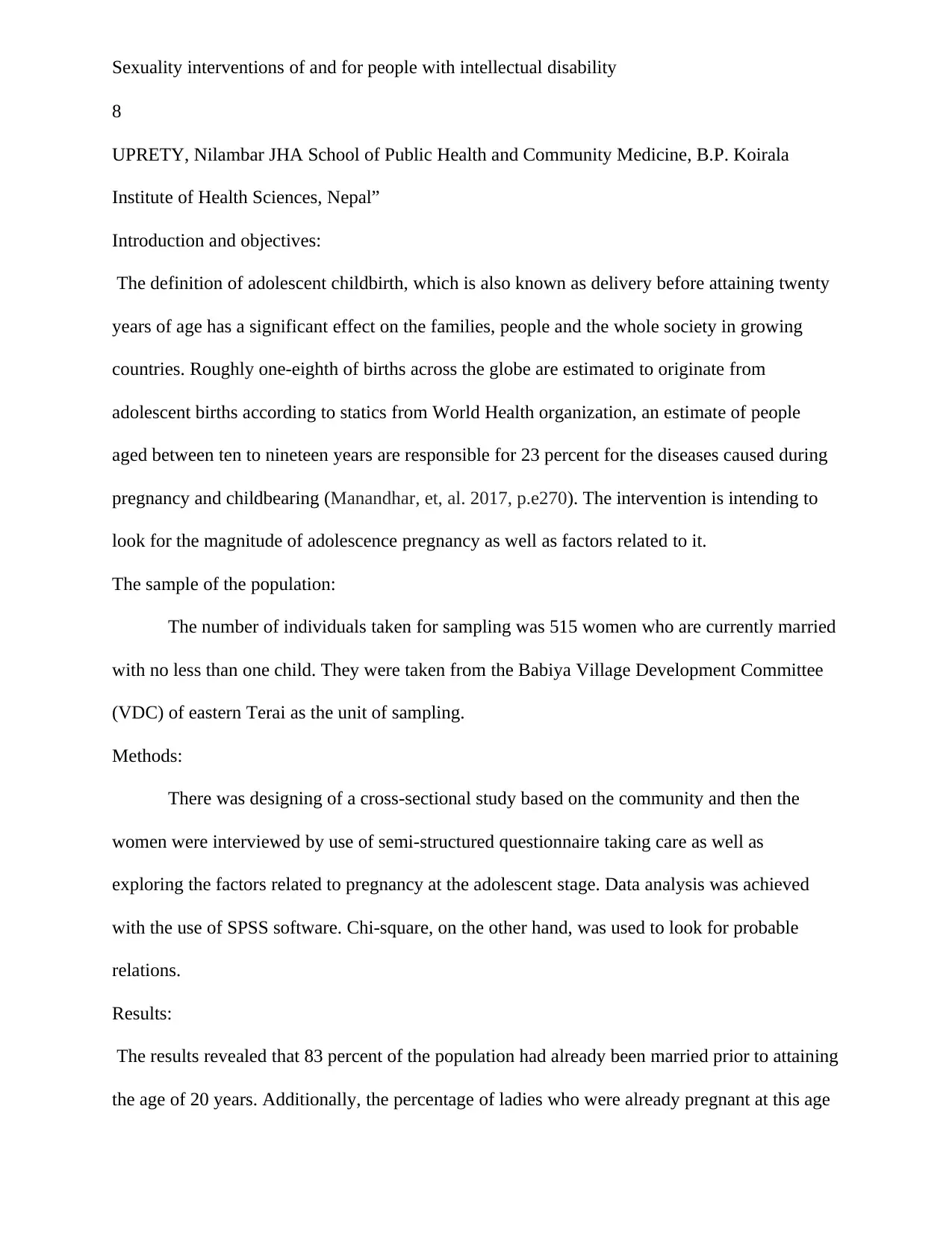
Sexuality interventions of and for people with intellectual disability
8
UPRETY, Nilambar JHA School of Public Health and Community Medicine, B.P. Koirala
Institute of Health Sciences, Nepal”
Introduction and objectives:
The definition of adolescent childbirth, which is also known as delivery before attaining twenty
years of age has a significant effect on the families, people and the whole society in growing
countries. Roughly one-eighth of births across the globe are estimated to originate from
adolescent births according to statics from World Health organization, an estimate of people
aged between ten to nineteen years are responsible for 23 percent for the diseases caused during
pregnancy and childbearing (Manandhar, et, al. 2017, p.e270). The intervention is intending to
look for the magnitude of adolescence pregnancy as well as factors related to it.
The sample of the population:
The number of individuals taken for sampling was 515 women who are currently married
with no less than one child. They were taken from the Babiya Village Development Committee
(VDC) of eastern Terai as the unit of sampling.
Methods:
There was designing of a cross-sectional study based on the community and then the
women were interviewed by use of semi-structured questionnaire taking care as well as
exploring the factors related to pregnancy at the adolescent stage. Data analysis was achieved
with the use of SPSS software. Chi-square, on the other hand, was used to look for probable
relations.
Results:
The results revealed that 83 percent of the population had already been married prior to attaining
the age of 20 years. Additionally, the percentage of ladies who were already pregnant at this age
8
UPRETY, Nilambar JHA School of Public Health and Community Medicine, B.P. Koirala
Institute of Health Sciences, Nepal”
Introduction and objectives:
The definition of adolescent childbirth, which is also known as delivery before attaining twenty
years of age has a significant effect on the families, people and the whole society in growing
countries. Roughly one-eighth of births across the globe are estimated to originate from
adolescent births according to statics from World Health organization, an estimate of people
aged between ten to nineteen years are responsible for 23 percent for the diseases caused during
pregnancy and childbearing (Manandhar, et, al. 2017, p.e270). The intervention is intending to
look for the magnitude of adolescence pregnancy as well as factors related to it.
The sample of the population:
The number of individuals taken for sampling was 515 women who are currently married
with no less than one child. They were taken from the Babiya Village Development Committee
(VDC) of eastern Terai as the unit of sampling.
Methods:
There was designing of a cross-sectional study based on the community and then the
women were interviewed by use of semi-structured questionnaire taking care as well as
exploring the factors related to pregnancy at the adolescent stage. Data analysis was achieved
with the use of SPSS software. Chi-square, on the other hand, was used to look for probable
relations.
Results:
The results revealed that 83 percent of the population had already been married prior to attaining
the age of 20 years. Additionally, the percentage of ladies who were already pregnant at this age
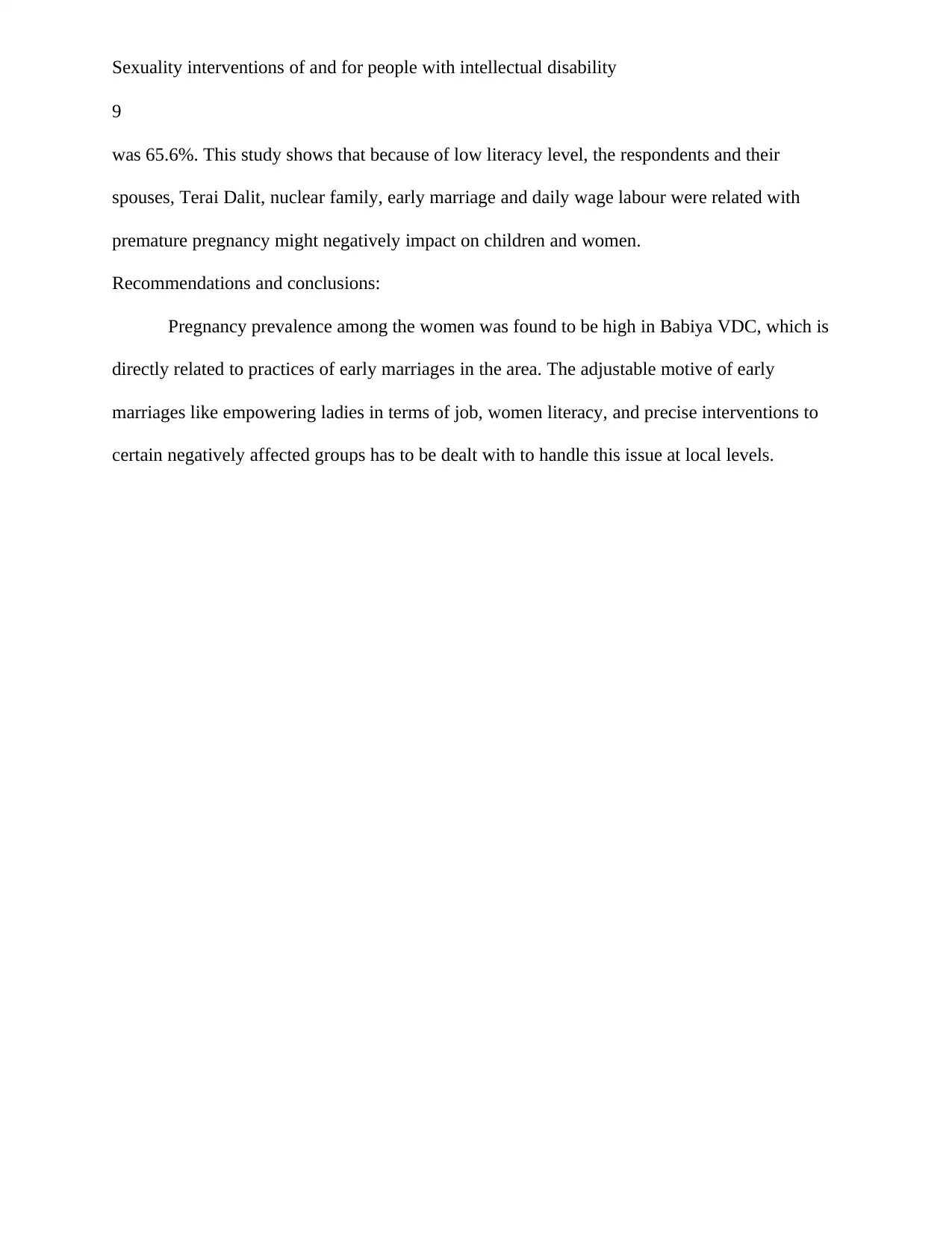
Sexuality interventions of and for people with intellectual disability
9
was 65.6%. This study shows that because of low literacy level, the respondents and their
spouses, Terai Dalit, nuclear family, early marriage and daily wage labour were related with
premature pregnancy might negatively impact on children and women.
Recommendations and conclusions:
Pregnancy prevalence among the women was found to be high in Babiya VDC, which is
directly related to practices of early marriages in the area. The adjustable motive of early
marriages like empowering ladies in terms of job, women literacy, and precise interventions to
certain negatively affected groups has to be dealt with to handle this issue at local levels.
9
was 65.6%. This study shows that because of low literacy level, the respondents and their
spouses, Terai Dalit, nuclear family, early marriage and daily wage labour were related with
premature pregnancy might negatively impact on children and women.
Recommendations and conclusions:
Pregnancy prevalence among the women was found to be high in Babiya VDC, which is
directly related to practices of early marriages in the area. The adjustable motive of early
marriages like empowering ladies in terms of job, women literacy, and precise interventions to
certain negatively affected groups has to be dealt with to handle this issue at local levels.
⊘ This is a preview!⊘
Do you want full access?
Subscribe today to unlock all pages.

Trusted by 1+ million students worldwide

Sexuality interventions of and for people with intellectual disability
10
List of References
Lindroth, M., 2017. Transgender People and Sexual Health–Findings From a Swedish Interview
Study. The Journal of Sexual Medicine, 14(5), p.e270.
Manandhar, N., Bhattarai, S., Shrestha, A., Baral, D.D., Uprety, S. and Jha, N., 2017. Factors
Influencing Adolescent Pregnancy Among the Women of Rural Eastern Terai, Nepal. The
Journal of Sexual Medicine, 14(5), p.e270.
Morin, V., Levesque, S. and Lavigne, J., 2017. Female Masturbatory Practices and Sexual
Health: A Qualitative Exploration of Women's Perspectives. The Journal of
SexualMedicine, 14(5), p.e270.
Nuñez, J.C., Derluyn, I. and Valcke, M., 2017. Towards Building a Bridge: Exploring
Adolescents and Their Teachers’ Perceptions of Comprehensive Sexuality Education in
Ecuador. The Journal of Sexual Medicine, 14(5), p.e271.
Royneberg, A. and Lien, T.S., 2017. Transgender Youth and Sexuality–Experiences From Our
Empowerment Groups. The Journal of Sexual Medicine, 14(5), p.e271.
10
List of References
Lindroth, M., 2017. Transgender People and Sexual Health–Findings From a Swedish Interview
Study. The Journal of Sexual Medicine, 14(5), p.e270.
Manandhar, N., Bhattarai, S., Shrestha, A., Baral, D.D., Uprety, S. and Jha, N., 2017. Factors
Influencing Adolescent Pregnancy Among the Women of Rural Eastern Terai, Nepal. The
Journal of Sexual Medicine, 14(5), p.e270.
Morin, V., Levesque, S. and Lavigne, J., 2017. Female Masturbatory Practices and Sexual
Health: A Qualitative Exploration of Women's Perspectives. The Journal of
SexualMedicine, 14(5), p.e270.
Nuñez, J.C., Derluyn, I. and Valcke, M., 2017. Towards Building a Bridge: Exploring
Adolescents and Their Teachers’ Perceptions of Comprehensive Sexuality Education in
Ecuador. The Journal of Sexual Medicine, 14(5), p.e271.
Royneberg, A. and Lien, T.S., 2017. Transgender Youth and Sexuality–Experiences From Our
Empowerment Groups. The Journal of Sexual Medicine, 14(5), p.e271.
1 out of 10
Related Documents
Your All-in-One AI-Powered Toolkit for Academic Success.
+13062052269
info@desklib.com
Available 24*7 on WhatsApp / Email
![[object Object]](/_next/static/media/star-bottom.7253800d.svg)
Unlock your academic potential
Copyright © 2020–2025 A2Z Services. All Rights Reserved. Developed and managed by ZUCOL.





